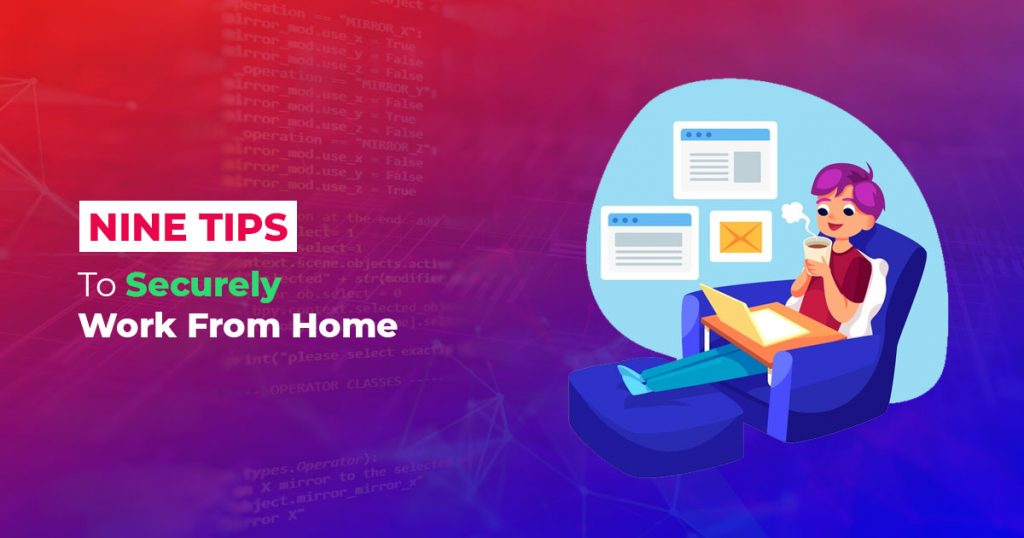This blog is about Tips to Securely Work from Home. Indeed, even before the COVID-19 flare-up, employees were increasingly working from home. Since the World Health Organization announced COVID-19, a pandemic, numerous organizations ask that their employees work from home. As more individuals sign into networks from home, there is an expanded danger of hackers opening ways. Also, hackers are utilizing this pandemic as yet another way to deploy their assaults. In this condition, it is a higher priority than at any other time to rehearse great security propensities. Tips to Securely Work from Home are beneficial if appropriately implemented.
Following are Tips to Securely Work from Home:-
1. Check the Sites You Visit for TLS/SSL
While searching on the web from home, ensure you are visiting approved sites. Various browsers have novel identifiers to show if a site is secure and verified. View what a safe website looks like on famous browsers to know how to differentiate from potential phishing destinations.
2. Secure Your Network
A hacked network can mean admittance to the system by unapproved clients. Eliminate this chance through controlling who can get access to the network. Use multifaceted verification (MFA) to guarantee that only approved clients can get to a controlled system, for example, your company platform. In contrast with the company network, the home network is less secure because an Intrusion Detection System is absent (IDS) and Intrusion Prevention Systems (IPS) in a home domain. Furthermore, working distantly requires a reliable, secure web connection. When working from home, guarantee that your home network has a solid password and, if conceivable, attempt to isolate your PC network with your IoT devices network. Follow these eight stages to more grounded Wi-Fi security to make sure about your home network. If you decide to work from a cafe or other public space, be careful with available Wi-Fi and don’t trust open systems. Ensure your device isn’t set to auto-connect with any Wi-Fi signal it meets. If possible, utilize your mobile as a hotspot. Likewise, you can kill network discovery so that your work PC is hidden from other PCs on the network.
3. Secure Your Email
It may appear fundamental, yet ensuring that you separate your work email from your email can shield you from assaults. It’s essential for a virus from your email to infect a work email also. You may think about utilizing an alternate device for each, or at least a different login.
4. Secure Your Physical Devices
Network protection and physical security are equally significant. Keep your physical workspace secure and securely store your work devices every night. Try not to move back from your PC with it opened. If possible, attempt to exclusively utilize your work PC to interface to the company environment as opposed to utilizing your PC. Furthermore, try not to permit relatives to utilize your work devices. This is another reason to think about using an alternate PC for work and individual motivations.
5. Beware of Phishing Attacks
As demand for specific items will rise and this pandemic’s financial impact will apply to everybody, be careful with new techniques actualized by hackers to use this surface to send their assaults. Email with subjects, for example, “Best Stocks to invest resources into during pandemic,” “Free supplies gave by FEMA,” and comparative themes are frequently intended to draw in clicks. They likewise require a more significant security review since they may convey a destructive payload.
6. Collaborate Remotely
It tends to be hard to involve with colleagues while working distantly. You may consider setting up every day check-ins to refresh project statuses, get feedback, and talk about overcoming detours. Online collaboration tools can assist but keep in mind that even those tools are open to vulnerabilities. In January, Check Point Software found an imperfection in Zoom, which permitted eavesdrop to listen to private Zoom meetings. While the defect has been settled, it’s essential to stay watchful when utilizing online collaboration devices and screen the news for any events. Online video conference platforms like Zoom regularly have an authentication functionality for each meeting. Ensure you use this functionality to forestall open sessions where anybody without validation can join.
7. Follow Company Policies
Organization guidelines ought to consistently be followed, yet it’s particularly significant when working from home. Report any suspicious behavior to your IT security division.
8. Update Your Emergency Contact Details
Finally, ensure that you have the right emergency contact data information listed so that if your organization sends out significant updates, they go to the correct accounts.
9. Don’t Forget the Basics
Work from home implies keeping the same good security cleanliness that we utilize at the workplace. Try not to tap on links in emails from individuals you don’t know about. Numerous organizations give admonitions in emails that begin outside the organization, so clients won’t be deceived in trusting a phishing email. Utilize a VPN while interfacing distantly to access company resources and confirm your machine to the corporate organization. Update anti-virus software consistently to get the latest signatures.
Stay up with the latest security patches (Windows and Mac). Also, do likewise for your phone, which might be accepting email from the network. The best defense is a defense-in-depth, so utilizing different security devices will help keep up a high-security status and shield your boss from getting contaminated with malware. While this is not a complete rundown to guarantee absolute security while working distantly, it is a decent beginning. Just staying alert that working from home can build your risk of cyber-attacks can help representatives be careful.
You might find several blogs on the web on Tips to Securely Work from Home during COVID-19, but we have explained. These Tips to Securely Work from Home are quite practical and useful.

